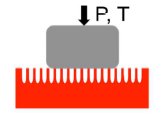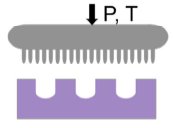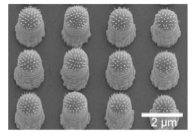Yale Researchers Create Multi-Scale Micro / Nano Patterns to Influence Cellular Responses
A research team from Yale University led by Themis Kyriakides, Associate Professor of Pathology and Biomedical Engineering, and Jan Schroers, Professor of Mechanical Engineering & Materials Science, has investigated cellular responses to novel multi-scale topographies fabricated with InRedox AAO as a template.
To create the multi-scale topology, the team hot-pressed an amorphous Pt-Cu-Ni-P metallic glass (Pt-BMG) alloy onto AAO wafers with 40nm pore diameter, resulting in a nanorod array Pt-BMG structure. The AAO was dissolved in KOH and then the Pt-BMG nanorod array was hot-pressed again into a silicon wafer with micro-scale cavities. The resulting Pt-BMG surface contained micrometer scale pillars, with arrays of nanorods on top of each pillar. Macrophages and fibroblasts were then cultured on this engineered substrate to evaluate the foreign body response. Of note, the different feature length scales induce specific cell responses and analysis of the macrophage fusion showed the advantage of the nano-patterns to prevent foreign body giant cells. The authors highlight that this technique could be used to create biomaterials which function better over longer periods of time.
Hierarchical Micro- and Nano-Patterning of Metallic Glass to Engineer Cellular Responses
Jennie Wang, Ayomiposi M. Loye, Jittisa Ketkaew, Jan Schroers, and Themis R. Kyriakides, ACS Appl. Bio Mater., 2018, 1 (1), pp 51–58
Role of AAO in this study:
- a low-cost template for creating metal surface with well-defined nanoscale topology for cell culturing
- AAO mechanical robustness and refractory nature allows hot-pressing of Pt alloy to create arrays of metal nanorods
- wide rage of available nanopore diameters enables follow-up studies of the impact of nanoscale topology on cell response





